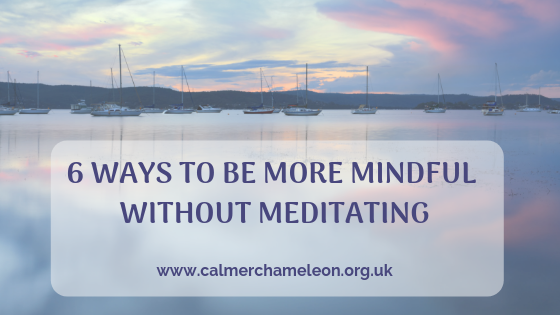6 Ways To Be More Mindful Without Meditating

Mindfulness isn’t for everyone, despite what the media would have us believe. Even as a mindfulness teacher, I’m sick of being bombarded by messages to meditate on this and mindfully perform that. The September 2018 issue of Women’s Health magazine even asks on its front cover whether I’m shagging mindfully under the headline of “Get It Om!”. Well Women’s Health magazine, that’s none of your damn business!
Meditation fail

I have a confession to make. Right now, I’m a lapsed meditator. When I’m teaching, I do meditate regularly because I would never ask a client or student to do something I’m not prepared to do myself. But for the last few months, meditation and me, it’s just not happening. We seem to be on a break, and I’ve been unfaithful with a whole load of other balms for the soul; chocolate and napping being my top two. My former teacher would have to give me the mindfulness equivalent of a truckload of Hail Marys to atone for my sins of omission. The thing is, I have no guilt about my failure to get my ‘tush on the cush’. I’m doing mindfulness my way.
Two types of mindfulness
There are two types of mindfulness; formal, involving different kinds of meditation, and informal, where you drop into the awareness of the moment. Right now, I’m going informal. Eminent mindfulness teacher, Jon Kabat Zinn defines mindfulness as:
…paying attention in a particular way: on purpose, in the present moment and
non-judgementally .
Living mindfully
If you want to live more mindfully, this is what is involved. It sounds simple, right? It’s just not always easy. The beautiful thing about mindfulness is that however many times you mess it up, you can always start again. Our minds evolved to jump around, to attend to lots of different stimuli in our environment so our attention is going to shift. Accept this. Don’t judge yourself harshly. Return to the present moment.
Informal mindfulness
I love how informal mindfulness has given me a richer life. I notice things more acutely now. Taking in all the details
Let me give you some concrete examples of informal mindfulness:
- Divine Driving Imagine you are driving to work. Your mind is full of the tasks you didn’t complete when you left the night before; the demands you know will be made on you in the day ahead. You start to feel tired and anxious. Then the ‘what ifs’ begin. What if I don’t get that project in on time? What if I run into the boss again and she has another go at me? You don’t even notice the route you’re taking. Your mind is in automatic pilot mode. If you want to practice informal mindfulness when your mind is distracted like this, one useful tip is to start by moving your attention to how your body feels. Notice the sensation of the steering wheel in your hands, the floor of the car and the pedals beneath your feet. Does the seat feel supportive of your body or are you uncomfortable? Move to include what you can see through the windscreen. Instead of just seeing other cars as objects to avoid, what shapes and colours are they today? If your mind starts to stubbornly return to your worries, notice this and then gently bring it back to really experiencing your surroundings. With practice, just paying attention to what all your senses are feeling in the present moment will allow you a break from your busy mind. There are so many opportunities to do this during an average day. Here are some more suggestions for things you can try.
- Boredom Buster Pick a boring, everyday task like cleaning your teeth. See if you can bring your attention to all the different sensations this task creates. The brush against your teeth, the tingle of the toothpaste, how you open your mouth and manoeuvre the brush. Try to do this task mindfully every day for a week.
- Tension Timeout Notice your breath. Don’t alter it in any way. Just pay attention to the way the air feels as it comes in through your nose or mouth. Feel the movement of your chest and abdomen as you take the air in and breath it out again. Notice whether the air has changed
temperature on the out breath. To help you remain focused on your breath, you can count each breath and start the count at 1 again when you reach 10. - Body Barometer If a sound interrupts your thoughts, like a ringing phone in the distance or a car horn, use that sound like a prompt to become aware of what’s going on for you. What are your emotions doing? Where are you feeling the emotions in your body? Anxiety and stress are often felt in the shoulders or stomach. Anger can be felt in the clenching of the jaw or taking up a different stance. Once you are aware of your emotions and what they are doing to your body, you have a choice to respond. If your shoulders feel tight, roll them, have a stretch. Notice the difference?
- Mindful Mouthfuls Every meal is an opportunity to experience your life mindfully. What are your thoughts about the meal in front of you? Does it conjure up memories of times when you’ve eaten this food before? Do you associate it with a certain person? Notice how your mouth will prepare for the arrival of the food, triggering saliva to help digest this fuel for your body. If there is something you dislike, how strong is your reaction? Distaste? Disgust? Or just a mild indifference?
- Sleepy Sensations Each night when you get into bed, spend a few moments focusing on how it feels to be lying down. You’ve finished your day. This is your time to prepare for sleep. Mindfully find a comfortable position to begin your night’s rest. If you have difficulty getting off to sleep, try counting your breaths and paying attention to the way your body feels. When your mind starts wandering off to thoughts, guide it back to concentrating on the breath and sensations of your body.
Hopefully, you can now see that you don’t have to adopt a lotus position and wear flowing robes, chanting loudly with your legs crossed in order to live mindfully. Just live your life. Bring your attention to what you’re doing as you do it. See what a difference that makes to the way you live.
I’d love to hear how you get on when you try these informal mindfulness tips. Let me know in the comments below.
If you need any further tips, get in touch via the contact page and we can see how mindfulness can help you.
